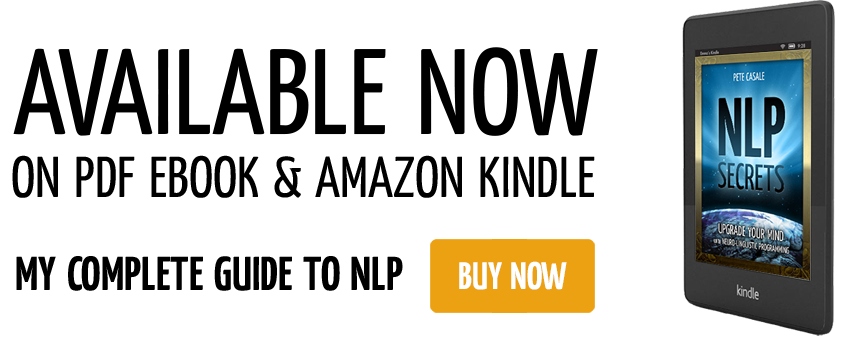 In my last article about the NLP technique framing, I used an example of negative framing to lessen the emotional impact of having a bad experience or memory. The case I used was a case of a bad job interview. By having the memory to lose its negative emotional attachments, it allows the user to learn better from the experience by being able to view it more objectively. It also makes the process of reliving the bad memory less traumatic, therefore more doable. The technique itself was negative framing, which means to lessen (negate) emotional impact of a certain memory. But what if we want to increase the impact?
In my last article about the NLP technique framing, I used an example of negative framing to lessen the emotional impact of having a bad experience or memory. The case I used was a case of a bad job interview. By having the memory to lose its negative emotional attachments, it allows the user to learn better from the experience by being able to view it more objectively. It also makes the process of reliving the bad memory less traumatic, therefore more doable. The technique itself was negative framing, which means to lessen (negate) emotional impact of a certain memory. But what if we want to increase the impact?
Positive framing is the same NLP process as negative framing, just it goes the other way round. So instead of being a normal memory moving into a dulled, framed memory, you can take a normal memory and amplify it into a strong, vivid memory.
Why would anyone want to do that? There are several reasons that I can think of for now:
- You may have a very nice memory of someone or something that you want to amplify.
- You may have an uncertain memory of a person, so you could use positive framing to investigate your feelings about that person.
- You may want to use a feeling you associate with a certain memory (such as the feeling of achievement associated with accomplishing a goal) that you want to harness and use with other NLP techniques, or use it as a trigger.
We'll do a simple exercise to explain positive framing. You probably can already figure out what to do, but I'm here to write my findings about NLP and to assume you understand a process from subtext alone would be a bit cheap, wouldn't it?
In this example, we're going to get ready for a job interview. Perhaps you aren't very confident when it comes to interviews, and you want to use positive framing get yourself into a more positive frame of mind - aha! See what I did there? Mildly clever wordplay is just one of the many benefits NLP-Secrets.com has to offer.
First of all, just picture yourself in a plain, empty room. Look at the picture of yourself. Don't force it to a certain setting, just ask yourself this:
What do other people see when they look at me?
That's the picture we want! What can you see? Which way are you facing? What are you doing? What are you wearing? Don't let it change based on these questions - just observe for now.
Now keep that picture of yourself, and now your pictured self has just been given the news that they got the job they wanted, AND they are getting paid twice as much as they thought! Watch your pictured self react to this news - in terms of body posture. Imagine the job being even better than expected, and watch yourself feel really proud and happy. See your neck perk and eyes light up!
Now put your pictured self in your job interview clothes. Ready to go for the interview, and already knowing that the job is a sure thing. Look how confident and excited you look, and double and triple that feeling.
Now bring vivid colours into the picture - feel the temperature of the room and the feeling of the clothes against your skin. Imagine the smell as if you've just brushed your teeth, a fresh, ready-to-go smell. Hear your own calm, confident breathing. Increase the size of the picture, so it's even closer. Notice how the excited, confident feeling increases as you widen the frame.
Now increase the picture even further, like a 90-foot LCD screen at point blank. Have your pictured self step out of the picture towards you and as this happens, sink yourself into the photo so that you are looking through your pictured self's eyes. Notice the feelings of excitement, pride and confidence beam and hum with intensity, as you look through your supercharged eyes. Take this feeling and use it. Focus on this feeling. Take as long as you need to realise that this "supercharged you" is you. It's not an imagined version of yourself, it actually is you. This is your self image, and it is all you need to be exactly the way you want to be. Your self image is immensely powerful, and you have 100% power over it. Use this as often as possible. This NLP technique never diminishes, it only gets stronger and faster and more brilliant with practice.
Positive framing is certainly one of the most powerful amplifier techniques NLP has to offer. This can be used to amplify any emotion and get your anchors and swish patterns really humming! For an example, I use framing with swish and anchors in the NLP phobia cure for the fear of flying. Have a look - you can modify it to work with most phobias - even the fear of job interviews :)
Next NLP Technique: NLP Meta Model

NLP Technique: Swish
Swish, also known as Swish Pattern, is an NLP technique that is very useful for replacing an unfavourable emotion or behaviour with a more useful one. With a little bit of creativity, Swish can be used to do a lot of useful things, such as make going to the gym more fun or making foods that are good for you taste better.

NLP Seduction
NLP Seduction is an entire art on its own. If you have a thorough understanding of NLP, seduction is a straightforward process. Some suggest that using NLP for seduction is unethical, and that we shouldn't use "mind control" for seduction, but I strongly disagree. Everyone who attempts seduction is using some form of mind control whether they know it or not. Buying flowers, wearing cologne, even having dinner with someone has far deeper psychological connections than you may expect, and are forms of mind control.

Upgrade Your Mind with NLP Secrets. Boost Confidence. Beat Anxiety. Quit Addictions. Build Rapport.